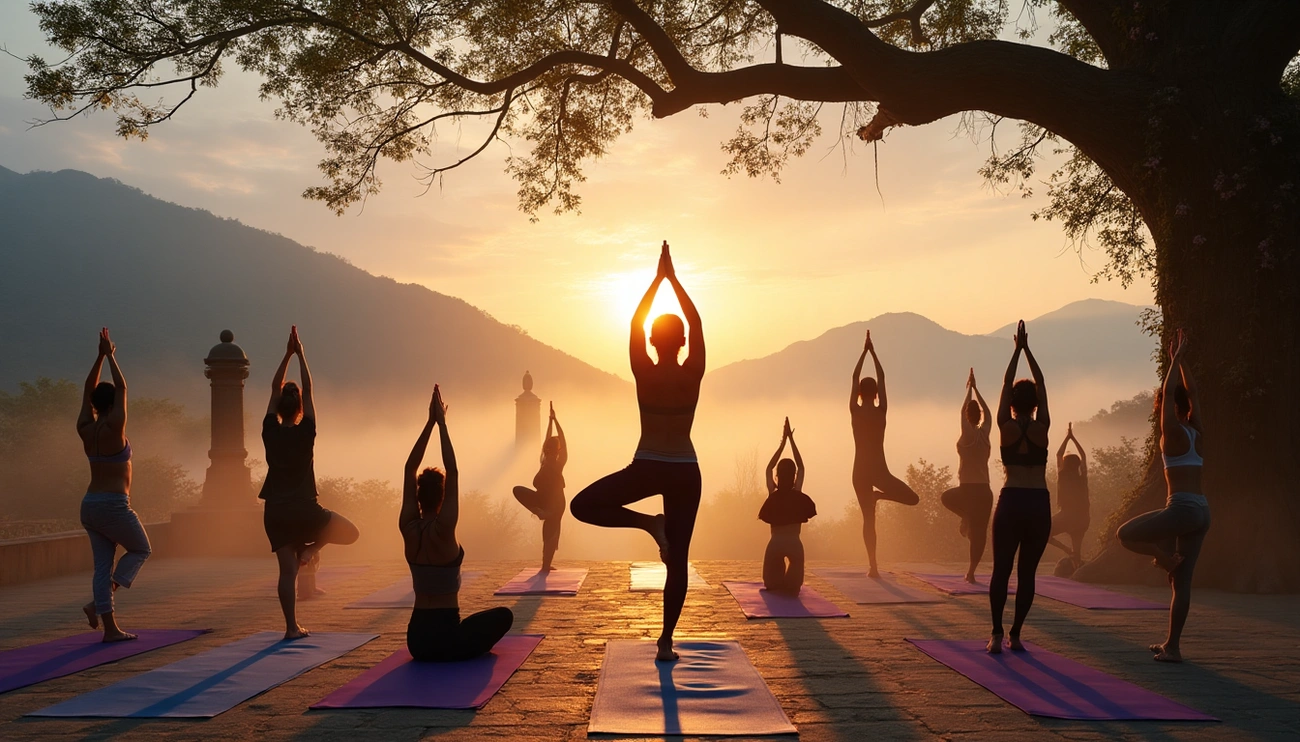
Yoga stands as one of the few ancient practices that has not only survived but thrived in our fast-paced digital world. International Yoga Day, celebrated annually on June 21st, reminds us of this enduring tradition that continues to transform millions of lives worldwide. Despite being thousands of years old, yoga remains remarkably relevant in 2025, offering solutions to many contemporary challenges we face.
As International Yoga Day 2025 approaches, many wonder what makes this practice so special and universally appealing. The benefits of yoga extend far beyond physical flexibility, affecting mental health, emotional balance, and even our immune systems. Additionally, research consistently demonstrates that regular yoga practice reduces stress levels by up to 27% and improves sleep quality by 35% in practitioners. The importance of yoga has consequently been recognized by health professionals, educational institutions, and corporations alike.
This comprehensive guide explores the rich history of International Yoga Day, examines its scientific benefits, discusses its evolution in the digital age, and explains why this ancient practice matters more than ever in our modern world.
The Origins of Yoga and the Birth of International Yoga Day
The story of yoga begins thousands of years ago, far before studios and yoga apps existed, with a practice deeply woven into the fabric of ancient Indian civilization.
Ancient roots of yoga in India
The word “yoga” derives from the Sanskrit root “yuj,” meaning “to join,” “to yoke,” or “to unite,” symbolizing the harmony between mind and body, thought and action, and human and nature. This profound concept reflects yoga’s holistic approach to wellbeing that has resonated across millennia .
While scholars debate exact origins, yoga’s earliest mentions appear in the Rig Veda, among the oldest sacred texts of Hinduism. In these ancient hymns, yoga refers both to the yoking of horses and the symbolic connection between the physical self and spiritual realm
Throughout history, yoga evolved across various spiritual traditions in India. Though primarily associated with Hinduism, Buddhism and Jainism developed their own yogic practices. According to some scholars, systematic yoga concepts emerged between 500-200 BCE in early Buddhist texts, the middle Upanishads, and the Bhagavad Gita .
Hindu tradition attributes special significance to Lord Shiva, often called the first yogi (Adi Yogi) and first guru (Adi Guru). Ancient legends suggest Shiva imparted yogic knowledge to his wife Parvati, which eventually reached humanity through various disciples .
UN recognition and the role of India in 2014
Yoga’s journey from ancient Indian practice to global phenomenon reached a milestone on December 11, 2014, when the United Nations officially proclaimed June 21 as International Yoga Day through Resolution 69/131 . The path to this recognition began with India’s Prime Minister Narendra Modi.
On September 27, 2014, addressing the 69th session of the UN General Assembly, Modi proposed establishing an International Yoga Day, describing yoga as “an invaluable gift of India’s ancient tradition” . His proposal emphasized yoga’s benefits beyond physical exercise, highlighting its capacity to foster oneness with self, world, and nature.
The response was overwhelming. The draft resolution establishing International Yoga Day received broad support from a record 175 member states . In fact, 177 nations co-sponsored the resolution in the United Nations General Assembly, where it passed unanimously. This unprecedented level of support underscored yoga’s universal appeal and recognized value.
Accordingly, the first International Yoga Day was celebrated worldwide on June 21, 2015. Since then, the annual observance has grown immensely, with participation across cultures, religions, and geographic boundaries.
Why June 21 was chosen
The selection of June 21 holds special significance for both astronomical and cultural reasons. First, this date marks the summer solstice in the Northern Hemisphere—the longest day of the year .
Throughout history, the summer solstice has represented a symbolic harmony between nature and human wellness in many cultures worldwide . This alignment perfectly complements yoga’s fundamental philosophy of unity and balance.
In the traditional Indian calendar, the summer solstice marks the transition to Dakshinayana, an important astronomical shift . Furthermore, in Hindu mythology, this period connects to spiritual teaching—legend holds that Shiva began imparting yogic knowledge to humanity on this day .
The choice of the summer solstice therefore represents more than convenience; it embodies yoga’s essence of harmony between human existence and natural cycles. This thoughtful selection highlights how International Yoga Day honors both the practical benefits and philosophical depth of this ancient practice.
Scientific Benefits of Yoga in 2025
Research continues to validate what yogis have known for centuries: yoga offers profound benefits for both body and mind. As International Yoga Day 2025 approaches, scientific studies have uncovered impressive evidence explaining why this ancient practice remains essential in our modern world.
Improved flexibility and strength
The physical benefits of yoga extend far beyond the obvious. Regular practice significantly enhances flexibility—studies show improvements of up to 35% after just eight weeks of consistent yoga. This increased range of motion helps practitioners move more freely while reducing everyday discomfort.
Contrary to common perception, yoga builds remarkable strength. Many poses naturally engage multiple muscle groups simultaneously, developing functional strength that serves us in daily activities. Standing poses strengthen hamstrings, quadriceps, and abdominal muscles, whereas poses like upward dog specifically target lower back muscles.
For older adults especially, yoga offers crucial benefits. Research indicates it’s particularly effective at improving flexibility and balance in adults over 65 , helping maintain independence and reducing fall risk. Additionally, yoga enhances cardiovascular fitness and exercise capacity—even previously sedentary individuals showed greater muscle strength, endurance, and cardio-respiratory fitness after practicing yoga for just 180 minutes weekly over eight weeks .
Mental clarity and reduced anxiety
The impact of yoga on mental health is perhaps even more remarkable. Neuroimaging studies reveal that regular practice actually changes brain structure, increasing gray matter volume in areas responsible for language, memory, learning, and decision-making. Moreover, yoga positively affects the hippocampus, amygdala, prefrontal cortex, and cingulate cortex—brain regions crucial for emotional regulation and cognitive function.
For those struggling with anxiety, yoga offers substantial relief. A randomized controlled trial found yoga significantly more effective than standard stress management education for generalized anxiety disorder, with 54% of yoga practitioners showing meaningfully improved symptoms. This anxiety-reducing effect may be partially explained by yoga’s ability to increase levels of gamma-aminobutyric acid (GABA), a neurotransmitter that slows brain activity and promotes calm.
Beyond anxiety relief, yoga has demonstrated effectiveness for depression. Multiple studies confirm it can improve short-term depression symptoms, likely through its impact on neurotransmitters and stress reduction.
Better sleep and immune function
Sleep quality significantly improves with regular yoga practice. A meta-analysis of 16 randomized controlled trials confirmed yoga’s positive effects on sleep quality using standardized measurement tools. For individuals with chronic insomnia specifically, personalized yoga practices improved subjective sleep parameters and reduced nighttime arousals.
Furthermore, yoga appears to enhance immune function through multiple pathways. Studies show it can increase natural killer (NK) cell percentages—important immune cells that help fight cancer and infections. Additionally, yoga decreases inflammation markers throughout the body, potentially reducing the risk of numerous chronic diseases.
Cancer patients particularly benefit from yoga’s immune effects. One study found significant improvements in NK cell percentages among patients with metastatic breast cancer who practiced yoga compared to control groups. Yoga also helps normalize cortisol rhythms, which play a crucial role in immune regulation.
Yoga as preventive healthcare
Increasingly, healthcare systems recognize yoga as valuable preventive medicine. Its ability to lower blood pressure, reduce cholesterol, and improve immune function makes it particularly beneficial for cardiovascular health. This has led to yoga’s inclusion in many cardiac rehabilitation programs.
For those concerned about bone health, yoga serves as effective prevention against conditions like osteoporosis by building both bone and muscle strength. Additionally, it helps counter the effects of sedentary lifestyles, addressing issues like sarcopenia (age-related muscle loss) and balance problems.
Notably, yoga therapy has expanded beyond typical studio settings into hospitals, where it’s offered as both preventive care and healing modality. Unlike one-size-fits-all approaches, yoga therapy is tailored to individual needs, making it particularly effective for addressing specific health concerns.
As we celebrate International Yoga Day 2025, the scientific community continues validating this ancient practice’s remarkable benefits—proving that yoga remains not just relevant but essential for modern health and wellbeing.
Yoga in the Digital Age
Technology has revolutionized how we experience ancient practices, nowhere more visibly than in yoga. As International Yoga Day 2025 approaches, the intersection of tradition and technology offers new pathways to practice this timeless discipline.
TOP YOGA EVENT ..https://asivanayoga.com/blogs/yoga-blog/complete-list-yoga-festivals
Rise of yoga apps and virtual classes
The COVID-19 pandemic permanently altered the yoga landscape, with many instructors adapting to online teaching through various platforms . This digital transition made yoga more accessible than ever before. Popular apps like Alo Moves, Asana Rebel, and Daily Yoga now offer extensive libraries catering to practitioners of all levels.
Indeed, the customization options are impressive. Down Dog provides over 30,000 unique class combinations, allowing users to select practice length, flow speed, preferred soundtrack, and even instructor voice . Similarly, Glo offers expert instruction blending ancient traditions with modern insights for practitioners from beginners to advanced yogis .
Virtual platforms have become essential tools for teachers as well. Zoom emerged as the preferred live streaming platform for hosting group or individual sessions, enabling instructors to provide personalized feedback similar to in-studio experiences. Concurrently, YouTube serves as an ideal platform for attracting new students through free yoga classes and tutorials.
Social media’s role in spreading awareness
Instagram has transformed into a yoga hub with over 60 million posts tagged #yoga as of early 2019. This visually-driven platform has birthed a vibrant community of practitioners who share their journeys and inspire millions globally.
However, research reveals a concerning trend: online yoga representation often emphasizes physical benefits rather than spiritual aspects. The most common words associated with #yoga include #fitness, #gym, #workout, and #fit . Furthermore, very few spiritual symbols or meditative postures appear in popular yoga images on social media.
Nevertheless, social media has democratized yoga, making it more accessible across geographical boundaries. During pandemic lockdowns, these platforms became crucial for maintaining practice and community. They continue to play a pivotal role in spreading awareness about International Yoga Day celebrations worldwide.
Wearables and tracking yoga progress
Smart yoga devices represent the latest frontier in practice enhancement. Modern wearables provide detailed analysis of body alignment, posture, and movement through sensors typically embedded in bands, straps, or yoga clothing.
Key features of these devices include:
- Real-time feedback with instant notifications about posture changes
- AI-powered personal coaching that identifies user-specific patterns
- Built-in applications with guided courses and progress monitoring
- Heart rate variability tracking during different poses
The benefits extend beyond technical improvement. Wearable technology offers motivation through concrete metrics, personalized practice recommendations based on individual needs, and injury prevention through alignment corrections. As technology evolves, these devices will become increasingly sophisticated, offering more accurate data and personalized feedback.
This integration of tradition and technology represents an exciting evolution in how we celebrate practices like International Yoga Day, maintaining yoga’s core values while expanding accessibility and effectiveness.
Global Participation and Cultural Impact
From massive gatherings in India to quiet sessions in New York’s Times Square, International Yoga Day has grown into a truly global phenomenon, transforming June 21st into a worldwide celebration of wellness and unity.
How countries celebrate International Yoga Day
Across the globe, International Yoga Day is marked with diverse and vibrant celebrations. In India, the birthplace of yoga, the first International Day of Yoga set two Guinness World Records—for the largest yoga class and the most nationalities participating in a single yoga event. The United Nations Headquarters in New York hosts special events featuring yoga sessions and cultural performances, with the 2023 theme being “Yoga for Vasudhaiv Kutumbakam” (Yoga for “The World is One Family”) .
Other notable celebrations include:
- China’s massive gatherings, with one event in Wuxi attracting 10,000 participants
- United Kingdom’s parliamentary support through a dedicated League for yoga promotion
- Japan’s cultural exchanges and yoga sessions, including their own Parliamentary League
Given the COVID-19 pandemic’s impact, many celebrations moved online, enabling safer participation through virtual yoga sessions and workshops .
Yoga as a unifying global practice
In essence, yoga has emerged as a powerful force for global unity. Prime Minister Modi emphasized that “yoga has become a unifying force, bringing together people across cultures and backgrounds”. This sentiment is echoed by the record support for International Yoga Day’s establishment—the resolution received endorsement from an unprecedented 175 member states.
Throughout celebrations worldwide, yoga demonstrates its ability to transcend cultural boundaries. As stated by the UN, the International Day of Yoga “fosters unity and harmony, transcends borders and cultures, and brings us closer to a world of peace and well-being” .
Inclusion of yoga in schools and workplaces
Apart from public celebrations, yoga has found its way into educational institutions and corporate environments. Workplace celebrations often include tech-free hours, gratitude lists, organized retreats, and meditation sessions. These practices emphasize yoga’s role in promoting wellness and community even in professional settings.
Generally, this integration reflects growing recognition of yoga’s holistic benefits for both individual and community health worldwide.
Why Yoga is More Than Just Exercise
Beyond the physical postures lies the true essence of yoga, a comprehensive system designed to harmonize mind, body, and spirit. As International Yoga Day approaches, understanding these deeper dimensions becomes increasingly relevant.
Spiritual and philosophical dimensions
At its core, yoga embodies a spiritual path leading to self-realization. The word “yoga” itself comes from Sanskrit, meaning “to join” or “to unite,” representing the connection between individual consciousness and universal consciousness. Unlike conventional exercise, yoga’s ultimate goal is achieving “samadhi” – a state of profound inner peace through integration of our physical, mental, and spiritual selves.
The philosophical foundation of yoga is codified in ancient texts like the Yoga Sutras of Patanjali, which outlines ethical principles, self-discipline, and methods for attaining liberation from suffering . Fundamentally, yoga teaches that everything in the universe is interconnected, encouraging practitioners to live harmoniously with themselves and their surroundings.
Mindfulness and self-awareness
Essentially, yoga fosters heightened self-awareness through mindfulness practices. When practicing yoga, brain cells develop new connections, with physical changes occurring in brain structure and function. Studies using MRI scans reveal that regular practitioners have thicker cerebral cortex and hippocampus compared to non-practitioners, potentially counteracting age-related cognitive decline .
This mindfulness component distinguishes yoga from mere physical exercise. Through breath regulation, meditation, and focused attention, yoga encourages practitioners to observe thoughts and emotions without judgment. This non-reactive state helps break cycles of anxiety and rumination, with research showing regular mindfulness practices can lead to a 30% improvement in mood and emotional well-being.
Yoga as a lifestyle choice
Ultimately, yoga represents a comprehensive approach to living. Unlike conventional exercise focusing primarily on physical fitness, yoga encourages holistic wellness across mental, physical, emotional, and spiritual dimensions .
The regular practice strengthens the vagal tone which controls the body’s rest and digest functions, reducing stress levels and improving sleep quality. Furthermore, yoga stimulates the production of endorphins and oxytocin – essential hormones for happiness and well-being.
For many practitioners, yoga transforms from a periodic activity into a guiding philosophy that informs daily choices about diet, sleep, stress management, and interpersonal relationships. This lifestyle integration helps create balance and sensitivity across subtle layers of self-awareness, addressing root causes of many modern lifestyle diseases.
The Enduring Relevance of Yoga in Modern Life
Ancient wisdom meets modern science when we examine yoga’s journey through time. Throughout this exploration, we’ve seen how a practice born thousands of years ago continues to transform lives across our increasingly digital world. Yoga transcends mere physical exercise, offering a comprehensive system for wellbeing that addresses contemporary challenges of stress, disconnection, and lifestyle diseases.
Scientific evidence undeniably supports what practitioners have experienced for generations. Regular yoga practice strengthens bodies, calms minds, improves sleep quality, and boosts immune function. These benefits explain why medical institutions worldwide now recommend yoga as both preventive care and complementary therapy for numerous conditions.
Technology has certainly changed how we access yoga. Apps, virtual classes, social media communities, and wearable devices have democratized this ancient practice, making it available regardless of location or schedule constraints. Still, the essence remains unchanged—yoga continues to foster unity between mind, body, and spirit despite these modern adaptations.
The worldwide celebration of International Yoga Day stands as testament to yoga’s universal appeal. Countries across continents embrace this tradition, recognizing its power to unite people beyond cultural, religious, and geographic boundaries. Schools, workplaces, and healthcare facilities likewise incorporate yoga, acknowledging its profound impact on wellness and productivity.
Perhaps most significantly, yoga offers something our fast-paced world desperately needs—an invitation to slow down, connect with ourselves, and cultivate mindfulness. Though thousands of years old, this wisdom feels remarkably fresh and necessary today.
International Yoga Day 2025 therefore represents more than a celebration of physical postures. It commemorates a living tradition that continues to evolve while remaining true to its core purpose: guiding humans toward balance, awareness, and connection. Yoga’s enduring relevance proves that sometimes, ancient wisdom provides exactly what modern life requires.





